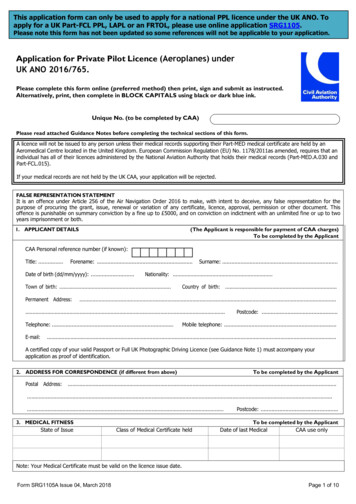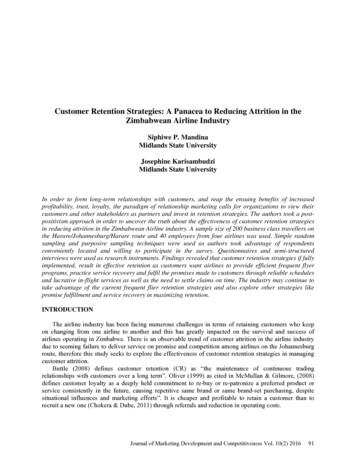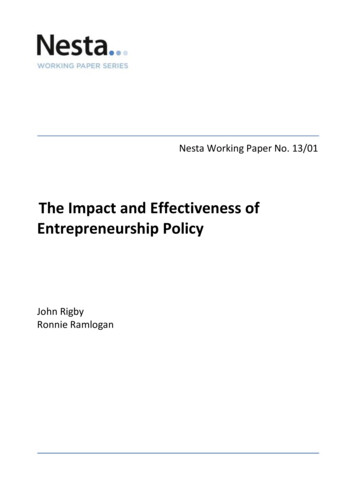
Transcription
MIDLANDS ENGINEREGIONAL ECONOMIC IMPACT MONITOREDITION 28: JUNE 2022
Executive SummaryThe June 2022 version of the Midlands Engine Regional Economic Monitor reports half way through anotherturbulent year for businesses and the whole economy. Inflation looks to be heading towards double-digit figures,weighing heavily on companies and communities across the region. The main pinch points for businesses relate to:1) Labour costs and shortages: increasing demand for higher wages coupled with a shortage of capable workers2) Utility costs: energy prices for businesses (not protected by an energy cap) are likely to go up further in October3) Fuel costs: both as an input to production as in relation to distribution4) Material / other commodity costs and shortages: including food and wider inputs like fertilizer, steel and cementValidated by similar feedback from major representative organisations (MakeUK, FSB, NFU etc), these growing costissues are cross-sector and, unfortunately, have seemingly restricted the regional economic growth reboundanticipated this year, as the world emerged from the depths of the pandemic. Instead, cashflow in businesses isbeing severely damaged, likely contributing to a continuing uptick in company insolvencies and a wider economicdownturn – as reported in this monitor through recent data releases: The West Midlands Business Activity Index decreased from 54.5 in April 2022 to 49.7 in May 2022, the firstcontraction in 16 months. While the East Midlands Business Activity Index decreased from 58.1 in April 2022 to51.8 in April 2022, the lowest reading since June 2020. The Midlands Engine total Gross Value Added (GVA) has decreased from 249.2bn in 2019 to 240.3bn in 2020.This equated to a 3.6% annual decrease, reflecting the UK trend (-3.4%). Quarterly Gross Domestic Product (GDP) analysis for Q3 2021 shows there was a quarter-on-quarter contractionof 0.6% in the West Midlands and a contraction of 0.5% in the East Midlands (since Q2), while England overallincreased by 0.6%. The industry level data suggests the Midlands declineis driven by the manufacturing sector.These figures reflect the challenging picture for the Midlands Engine economy, demonstrating the disproportionateeconomic shock of the pandemic years, as well as a lower than-average recovery in more recent time periods.However, this month’s monitor also evidences reason for optimism in what is a mixed picture in the Midlandseconomy. This is underpinned by several more positive data / insight releases, all driven by an underlying resilience inthe region’s business environment, and confidence in the Midlands’ offer as a place for investment and demand. The West Midlands reported the highest business confidence of all regions in the latest Business Barometerfrom Lloyds Bank Commercial Banking (June), and the business confidence in the East Midlands rose nine points. The Midlands is still a top destination for Foreign Direct Investment. Even during years of the pandemic, FDI hasheld strong and increased year-on-year at a higher rate than the national average. Other signs of a structurally sound business environment are reflected, such as historically high equity investmentlevels across the Midlands, and new analysis to re-affirm the Midlands as a start-up hotspot with an SME basethat is growing faster than several regions including London, the South East, Eastern and the North. Additionally, the labour market continues to recover with claimants continuing to fall across the Midlands: therewere 277,775 claimants the Midlands Engine area in May 2022, a decrease of 3,095 claimants since April.But, as re-affirmed by the first report of The UK Productivity Commission, its well-known that the Midlands lagsbehind the national average for productivity – a key factor for prosperity and standard of living. This is likely due tomultiple complex reasons, some of which are explored in the pages below, critically as part of the region’s responseto its currently uncertain and stagnating economic predicament: Skills and Labour Shortages: Both a structural / long-term problem and immediate issue: 38.6% of West Midlandsbusinesses and 40.8% of East Midlands businesses recently reported to be experiencing a shortage in workers.Looking to the future, there are important shifts in skills and labour requirements to consider across sectors,including the integration of green and digital roles within traditional roles and sectors; as explored in Section 4. Industry Mix: Due to the impact of major global shocks (e.g. Brexit, Covid, Ukraine), the importance ofmanufacturing (particularly automotive) in the Midlands may have restricted growth in recent years – as exploredin Section 3 (growth by sector and Brexit) and Section 5 (energy costs). But as a sector it will be a critical enabler offull economic recovery and growth in the Midlands, including decarbonisation and digitalisation. Supporting Firms Beyond Start-Up: Quantuma’s business distress data suggests that more support for businessesmay be required in the post-start-up phase – reflecting that companies in the 3-7 age bracket make up 43% ofseverely distressed businesses in the Midlands (compared to 38% in the UK as a whole).All of the above will be important considerations for Midlands Engine partners moving into the second half of 2022.Data and insight will continue to be integral to our approach, with new releases (including the first Census 20212releases, as per Section 6 of this Monitor) forming part of regional thinking and ultimately decision-making.
Policy arketKEY INSIGHTS Rising costs and prices continue to be a major business issue, particularly for utilities, wages andmaterials. This is damaging cash flow and likely contributing to a continuing uptick of companyinsolvencies. This has been dubbed a “cost of working crisis” by SMEs. Particularly high costs are:- Fuel and energy costs- Material costs such as steel, timber and cement- Other commodities such as food and fertilizer Business groups are calling for more action from government to curtail the pressure on businesses. This volatile economic climate stifles entrepreneurship and innovative investment, with the numberof regional start-ups reportedly falling in recent months. This is according to insolvency andrestructuring trade body R3 who found that there were 5,404 start-ups in the West Midlands inApril, a 21 per cent decrease on the March figure of 6,845. The East Midlands reported almost2,200 start-ups in April, also a decrease from March (-18%). There was a boost for the economy via the Jubilee weekend, but the prospect of regular trainstrikes is a major concern, on top of the increased cost of living crisis dampening consumerdemand. Other industries striking would obviously make this worse for wider parts of theeconomy; this includes teachers, nurses, and other public sector; but there is also strike actionmuted in some parts of the private sector as part of a possible “general strike”. There is a continually mixed picture across the Midlands business environment, though, with theWest Midlands reporting the highest business confidence of all regions in the latest BusinessBarometer from Lloyds Bank (June), and the East Midlands returning to growth. There have been further examples recently of regional businesses looking to re-shore and use localsupply chains as components and materials from global suppliers are not of sufficient quality forthe market, or firms are unable to get hold of them at all or at a reasonable price. More recent evidence points towards a so-far negative Brexit impacts on trade, disproportionatelyaffecting the Midlands. This comes from the Resolution Foundation’s “Big Brexit” report, whichfinds that, following the implementation of the TCA, the UK has suffered a broad-based fall in bothopenness and competitiveness in 2021. Linked to the UK’s new relationship with the EU, the government agreed to extend steelsafeguarding quotas on 15 steel products until 2024. While this has been welcomed as a win bysteel producers, domestic downstream manufacturers suggest it still threatens thousands of jobs. However, the 2022 EY Attractiveness Survey reports that FDI performance in the Midlands lastyear outpaced the rest of the UK. The West Midlands grew particularly well, reporting the numberof FDI-backed projects growing at a faster rate than the rest of the UK. The West Midlands hosted78 FDI projects in 2021, up 27.9% from the 61 projects located in the region in 2020. The EastMidlands hosted 39 projects, up 2.6 percent from 38 projects in 2020. Staffing and recruitment are a very hot topic for Midlands businesses - shortages and skills deficits,and wage pressures - all making it difficult for small companies to compete. Businesses across allsectors continue to struggle to find suitable staff to fill roles. Demand for flexible work, higher wages and lack of physical access to a workplace exacerbatesthis, but the core issue relates to a lack of skills and people in the labour market – with varyingrequirements for different generations.- Investment in new technology and machinery affecting ageing workforces- Reports that younger employees often do not remain in roles for the long term. Some sectors are increasingly more affected: e.g., social care, hospitality and production sectors. There are key questions being asked by businesses around:- Public facing roles -do people not want them?- Has the pandemic changed attitudes towards work?- Why aren’t people returning to workplace? Furthermore, some discussions have been had about what measures (if any) local businesses aredoing to support their own staff with the increase in household bills. Some businesses are payingstaff the living wage, rather than the minimum wage with these costs having a knock-on effect ofincreasing prices. While some business owners are considering giving staff a one-off payment to3help cover their utility costs.
1. Economic and Labour Market Impacts4
Global and National OutlookGlobalNationalIt was anticipated that following the Covid-19 pandemic,as happened after the last global pandemic, we mayexperience a ‘Roaring 20s’. However, instead it wouldappear we will be entering a period akin to the 1970s:stagflation looks like it is set to grip many countries.Stagflation is when there is persistent high inflation andstagnant demand, as happened in the 1970s.ONS announced that Consumer Price Inflation (CPI) hadrisen even further to 9.1% in the 12 months to May, upslightly from April’s rate of 9%. This is the highest rate ofinflation in 40 years since March 1982, and the Bank ofEngland is now forecasting that inflation could reach11%. ONS stated that inflation in May was fuelled byrising prices for food and non-alcoholic beverages. Theinflation in this sector is largely as a result of Russia’sinvasion of Ukraine severely restricting wheat and maizesupplies, from two countries which make up almost aquarter of worldwide production. Kantar is nowforecasting that the average annual grocery bill in theUK is now set to rise by 380 this year.Each G7 country has seen a decline in GDP over the firstquarter of this year, alongside rapidly rising rapidly risinginflation. The largest rises in inflation has been within theUK and US and forecasters are now anticipating thatinflation could climb to double figures this year in boththe UK and US.The main reasons for the rapidly rising global inflationare:1. Rapidly rising energy pricesEnergy prices are rapidly rising due to the Russianinvasion of the Ukraine. The G7 and EU countries haveannounced the phasing out or banning of imports ofRussian oil, with similar measures taken for coal andnatural gas. Several large oil companies have also ceasedoperations in Russia and many traders are boycottingRussian oil. Therefore, energy prices are expected toincrease by 52% globally in 2022, according to theWorld Bank.2. Supply Chain BottlenecksSupply chains are still being impacted by the lingeringimpacts of the pandemic, including disruptions in majorAsian ports and lockdowns in major cities within China.Furthermore, Russia’s invasion of Ukraine and itsrepercussions have led to severe physical and logisticaldislocations that havemagnified pre-existingbottlenecks.3. Wheat and Fertilizer price risesAgricultural prices are forecast to increase 18% thisyear, above previous projections, reflecting weakerproduction in Ukraine and Russia, alongside much higherinput costs, including for fuel, chemicals, and fertilizers.Russia and Ukraine are key exporters of wheat, togetheraccounting for about one-quarter of global wheatexports. Russia is also the world’s largest exporter offertilizers and has instituted new quotas and restrictionson exports. Fertilizer prices are expected to increase byaround 70% in 2022, due to soaring input costs,reduced production, and trade disruptions. As the priceof these two commodities continue to rise it will drivethe up the price of most foods and drinks goods, asthese commodities are key ingredients in the majorityof food and drink production.The rising food and drink costs are being compoundedby rapidly rising energy prices. Food and drinkproduction is highly energy intensive and the rapidlyincreasing energy prices will further push up costs forfood and drink manufacturing and production. This couldbe pushed onto consumers, as many firms in the UK arestruggling to absorb rapidly rising costs.In order to combat inflation, the Bank of England (BoE)has raised interest rates from 1% to 1.25%, theirhighest level for 13 years. The rise this month had beenexpected and it is anticipated that there will be furtherincreases this year. Some analysts are predicting thatthe BoE may go so far as to raise interest rates to 3% toquash inflation, however others are predicting it willpeak around 1.75%.Last year, OBR investigated the impact of long-lastinghigh inflation on the UK economy. This can happenwhen people think price rises will continue - businessesraise prices to keep making a profit and workers demandwage increases to keep up, developing into a wage-pricespiral. If this were to happen the interest rates mayreach 3.5%.Rail workers went on strike for three days in June,protesting the pay freeze and redundancies facing thesector. Last-ditch talks failed to resolve the dispute overjobs, pay and conditions, meaning some 40,000 RMTmembers at Network Rail and 13 train operatorswalked out. The Centre for Economics and BusinessResearch (Cebr) has found that the rail strikes will likelycost the economy at least 91m, warning that thisfigures could be much higher, especially for hospitalityand retail.Other sectors are now considering striking as well asthey also face redundancies and pay freezes.Source: City-REDI University of Birmingham5
Business ActivityBusiness Activity IndexExportsThe West Midlands Business Activity Index decreasedfrom 54.5 in April 2022 to 49.7 in May 2022, the firstcontraction in 16 months. Business activity was restricteddue to inflationary pressures, subdued demand,challenging economic conditions and input shortages.The West Midlands Export Climate Index decreasedfrom 53.4 in April 2022 to 52.8 in May 2022, this waslinked to the continual downturn to China (42.2). TheEast Midlands Export Climate Index remainedunchanged since April 2022 at 55.1.The East Midlands Business Activity Index decreased from58.1 in April 2022 to 51.8 in April 2022, the lowest readingsince June 2020. There was still an overall increase inbusiness activity in May 2022 which was linked to thedelivery of inputs and clearing of backlogs, although it wasrestricted due to hikes in prices and a drop in new orders.Business CapacityThe West Midlands Employment Index increased from55.1 in April 2022 to 55.3 in May 2022, taking thecurrent sequence of job creation to 15 months. TheEast Midlands Employment Index decreased from 55.5in April 2022 to 55.1 in May 2022, the rate of jobThe overall UK Business Activity Index decreased from 58.2 creation was the slowest since September 2021 due toefforts in cutting costs.in April 2022 to 53.1 in May 2022.The West Midlands and East Midlands Business Activity The West Midlands Outstanding Business Indexincreased from 50.2 in April 2022 to 51.3 in May 2022,Index trends:the fastest rate of growth since February 2022. The EastMidlands Outstanding Business Index increased from50.5 in April 2022 to 51.8 in May 2022, as materialdelivery delays pushed up work-in-hand.PricesThe West Midlands Input Prices Index increased from85.0 in April 2022 to 85.6 in May 2022. The latest rateof inflation accelerated to the second highest on record(Jan 1997). The East Midlands Input Prices Indexremained unchanged since April 2022 at 84.7.The West Midlands Prices Charged Index decreasedfrom 71.2 in April 2022 to 70.7 in May 2022. The EastMidlands Prices Charged Index slightly increased from70.2 in April 2022 to 70.3 in May 2022, the rate ofselling price inflation was the sharpest on record.OutlookThe West Midlands Future Business Activity Indexdecreased from 71.8 in April 2022 to 66.1 in May 2022,a 19-month low. The East Midlands Future ActivityIndex decreased 67.5 in April 2022 to 65.0 in MaySource: NatWest PMI, June 2022Of the 12 UK regions, the West Midlands and the East 2022, lowest since June 2020. Despite the level ofMidlands was third and fifth lowest respectively for the positive sentiment falling, firms in the Midlandsremained upbeat. Optimism was restricted due to acuteBusiness Activity Index in May 2022.inflationary pressures and impact on customerspending, issues with transportation, a challengingDemandeconomic climate and the Russian invasion.The West Midlands New Business Index marginallyincreased from 50.2 in April 2022 to 50.5 in May 2022. Out of the twelve UK regions, the West Midlands andThe East Midlands New Business Index decreased from the East Midlands were sixth highest and fifth lowest51.0 in April 2022. to 49.4 in May 2022, the first decline respectively for the Future Business Activity Index insince February 2021 due to lower purchasing power May 2022.among customers and supply-chain disruption .Source: NatWest PMI, June 2022. Located on the Midlands EngineHub is an Interactive Regional Business Activity Dashboard6
Labour Market Impacts: ClaimantsThere were 277,775 claimants aged 16 years and over in the Midlands Engine area in May 2022, a decrease of3,095 claimants since the previous month. This equated to a decrease of 1.1% for the Midlands Engine area,compared to a 1.5% decrease across the UK. There are 56,235 ( 25.4%, UK 26.7%) more claimants when comparedto March 2020. North East Lincolnshire (-280) and East Lindsey (-705) have lower levels than March 2020.The number of claimants as a percentage of residents aged 16 years was 3.3% in the Midlands Engine (UK 3.0%) inMay 2022 – remaining above the pre-pandemic levels of 2.7% (UK 2.4%) in March 2020.Claimants as Percentage of Residents Aged 16 Years and Over in May 2022:Out of the 1,511 wards within theMidlands Engine, 426 were at orabove the UK proportion of 3.0%for the number of claimants as apercentage of the populationaged 16 years and over in May2022.The wards with the highestnumber of claimants as apercentage of the populationwere based in Birmingham, withBirchfield and Handsworth jointhighest with 14.7%. This isfollowed by Lozells at 14.3% andthen Aston at 13.5%.There were 46,375 claimants aged 16-24 years old in the Midlands Engine area in May 2022 – a decrease of 1,000claimants since April 2022. This equated to a decrease of 2.1% with the UK decreasing by 2.5%. Since March 2020(44,195 claimants), the number of claimants aged 16-24 years old has increased by 2,180 ( 4.9%, UK 4.3%).Notably, 31 local authorities were lower than March 2020 levels and a further 1 was at the same level.The number of claimants as a percentage of residents aged between 16 and 24 years old was 4.0% in the MidlandsEngine and 3.6% for the UK in May 2022.Claimants as Percentage of Residents Aged 16 Years and Over in May 2022:Out of the 1,511 wards within theMidlands Engine, 597 were at orabove the UK proportion of 3.6%for the number of claimants as apercentage of the populationaged between 16-24 years old inMay 2022.The ward with the highest thenumber of claimants as apercentage of the population wasPortland (Mansfield) at 14.9%.This is by followed Oak Tree(Mansfield) at 12.8% and thenJoiner’s Square (Stoke-on-Trent)at 12.2%. In contrast, within theMidlands Engine there were 132wards with no youth claimantsin May 2022.Source: ONS/ Department for Work and Pensions, June 2022.Located on the Midlands Engine Hub is an Interactive Claimants Dashboard7
2. Business Environment8
Local Business IntelligenceThis report draws on contributions from the East It is noteworthy that recruitment difficulties are nowMidlands Chamber, Make UK, the NFU, and the FSB.being reported at all skill levels – including in relation tounskilled roles.East Midlands Council Regional OverviewThis section draws on full Q2 Quarterly Economic Survey Measures of future business confidence have softenedresults (QES).The overall State of the Economy Index somewhat in Q2 – although balances on expectations ofcompiled from the QES has softened since Q1.turnover and profitability remain positive. When askedabout their biggest current concerns, inflation is nowState of the Economy Index to Q2 2022:ranked highest by a large margin followed by access toskilled labour. Rising input cost pressures on businessesare not yet thought to have fed through into risinginsolvency rates, although this remains a future risk.Make UK - ManufacturingMake UK report a very volatile picture characterised bycontinuing uncertainty. Interestingly, their membershipreports differences in the regional picture of conditions –with both East and West Midlands said to be slowingrelative to a more buoyant East of England.The major story identified by Chamber members thismonth is of rising input costs on all sides. Where thisnarrative differs in relation to previous reports is in theranking of the factors driving this general picture: (1)Labour costs; (2) Utilities costs; (3) Fuel – both as aninput to production as in relation to distribution; and(4) Raw materials.Notwithstanding these pressures on firms, demand forthe goods and services that they supply is reported to beholding-up – with domestic demand reported to besomewhat stronger than that in overseas markets.Whether this will continue to be the case as the ‘cost ofliving’ crises impacts on household expenditure remainsto be seen.40% of Chamber members were reported to beoperating at full capacity. A figure that is reported to behigh by historic yardsticks and the balance on cashflowhas improved slightly since Q1. While around a third ofmembers indicate they intend to increase futurebusiness investment, in general, there is evidence thatinvestment intentions have softened in the context ofongoing uncertainties associated with fuel prices, theimpact of war in Ukraine and continuing disruption toglobal supply chains. Investment intentions droppedquarter on quarter for both investment in plant andmachinery and training. It has been suggested that witha significant proportion of firms now operating at or nearto full capacity, one would normally expect investmentintentions to be stronger. Recruitment remains asignificant business concern. Two thirds of membersreport that they have attempted to recruit. Of thesefirms, 82% have struggled to fill vacancies.Key concerns highlighted by manufacturers on order ofseverity include: (1) Recruitment; (2) Supply chainproblems; and (3) input price inflation including energy.Continuing disruption to supply chains and rising freightcosts over the last two years is said to have resulted inmany firms reviewing their supply chain arrangements.Make UK have characterised this as a shift in emphasisfrom Just in Time to Just in Case. While these supply chainproblems have been widely experienced since the onsetof the Covid-19 pandemic, they are now reported to bemore prevalent. It has been suggested that the costs ofinternational shipments alone has now reached a levelthat it has now affected the firms views on the merits ofoff-shore production. There is some evidence of firmsdiversifying supply chains as a means of promotinggreater resilience. It is also being reported that somefirms are stock-piling components and raw materials inorder both to ensure continuity of supply and as aresponse to the expectation of future input priceincreases.Rising energy prices remain a major concern formanufacturers. Firms are described as facing a particularproblem when existing energy supply contracts must berenewed. Many manufacturers have taken steps toreduce energy consumption/improve energy efficiency.Ongoing recruitment problems are reported to haveencouraged many employers to review non-monetarybenefits associated with employment as a means ofimproving the attractiveness of employment to existingand prospective employees. Replacement demand forskilled labour remains a major issue for manymanufacturing employers. Better access to EU employeesis reported as an ongoing requirement within the sector.9
Local Business IntelligenceRaw materials remain a major source of input costpressures on many manufacturers. War in Ukraine hasexacerbated the supply problems many had experiencedas a result of the Covid-19 pandemic. The combination ofprice, labour and supply issues noted above withincreasing uncertainty over levels of future demand formanufactures is reported to have affected futureinvestment intentions.FSB – Small Business Experiences - key concernsreported by Midlands SMEs: Cost of doing business crisis & inflationThe FSB quarterly Small Business Index report hadshown that SME business owners were feeling bullish atthe start of this year, paving the way for a strongsummer trading season. That rebound in activity is nowat serious risk, with surging costs weighing heavily onsmall business owners. Local consumer-facing firms,having been hardest-hit over lockdowns, are now caughtbetween customers less willing to spend and the need toincrease prices to cover surging outgoings, leading to aserious contraction in services output.FSB research shows that a fifth of small firms cite inputcosts as their main concern, along with surging energybills, travel disruption and the need to service debt, thecost of which is rising. The small business communityshrank in size to the tune of 400,000 over Covid-19lockdowns. If surging costs keep on unaddressed,hundreds of thousands more will be at risk.FSB is calling for urgent Government action, including:reversing hikes to national insurance contributions;reducing business rates for small firms; cutting VAT,especially on energy; and reducing fuel duty. Business financeSuccessful finance applications have plummeted to thelowest level on record. 9% of small firms applied forfinance in Q1 2022, the lowest proportion since SBIrecords began. The share that saw applications approved(43%) is also at a record low. The number of respondentsdescribing the availability of credit as “good” (19%) hastumbled to its lowest point since 2016. Of the few firmsthat did manage to secure finance, 42% plan to usecredit to manage cashflow, considerably more than thenumbers planning to use funds for equipment updates(21%), expansion (19%) or recruitment (4%). Labour MarketMany Midlands SMEs are reporting that recruiting staff isbecoming increasingly difficult and problematic. Thecombination of changed employee expectations (e.g.,reduced hours, work from home) plus the high demandfor labour across sectors and disciplines, are fuellingdemands for very high wages and favourableconditions.Even from those who are unskilled, inexperienced or newentrants to the labour market. While some larger firmsare able to go some way towards meeting theseexpectations and demands, smaller firms often lack thefinancial and developmental capacity to pay high wagesfor - and then develop - new starters. The problemseems widespread but is particularly acute in IT andbusiness & professional services, where ‘poaching’ oftalent by larger firms is becoming commonplace. Thetrend away from careers in relatively low-paid, highpressure sectors also continues, with acute shortagescited by local hoteliers, care providers, agriculturaltrades and service providers. Late Payment61% of small firms are being impacted by late paymentof invoices, with 26% saying the propensity for latepayment is growing. FSB is urging the Government toaccelerate delivery of our proposal to make AuditCommittees directly responsible for supply chain practiceto address this worrying trend, strengthen corporatesupply chains and create a thriving small businesscommunity driving economic growth from the ground up.NFU - FarmingSince the last Monitor, the Government has published itsfood strategy. The NFU report that a greater emphasison increasing self sufficiency in food production isnecessary. They also report an evident tension betweenthe government’s approach to trade deals with foodproducing nations and some of the objectives in thefood strategy relating to the development of thedomestic food industry. The major concern reported bythe farming sector echo those from other sectors - inputcosts are reported as rising on all sides. It is said to beinevitable that farmers input costs must be passed-onto consumers.A recent NFU survey reported that 87% of farmers thinkthat rising input prices will adversely affect theirbusiness. The poultry sector is reported to have beenparticularly hard hit by these problems as a result of bothrising wheat prices (used for feed and 57% more costlythan a year ago), energy costs associated with heatingpoultry sheds and the impacts of avian flu. Thesepressures are reported to have already fed through i
The June 2022 version of the Midlands Engine Regional Economic Monitor reports half way through another . may be required in the post-start-up phase -reflecting that companies in the 3-7 age bracket make up 43% of . All of the above will be important considerations for Midlands Engine partners moving into the second half of 2022.










